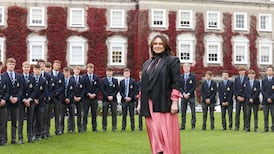Today the President visits the Liberty Crèche, established just 110 years ago by a group of genteel Protestant ladies and a gentleman of Dublin to provide day-care for the children of the street-traders of the capital, writes Kevin Myers.
Ah, if we could only travel back in time to see what a vile place Dublin was then, hideously divided by class and religion, with the affluent and largely unionist self-governing suburbs of Rathmines, Rathgar and Pembroke, and the teeming, filthy tenements of the city centre.
It is easy now to make fun of Mrs Goodbody, Mrs Roberts, Miss Emily Webb, Mrs Allen, and Mr T. Webb, as they brought their brand of Protestant charity to the deserving poor of the city centre, but they were truly before their time. Unlike almost any other contemporary charitable institution in Dublin, the Liberty Crèche was totally non-sectarian.
It wasn't quite the first crèche in Dublin. There was one in Wentworth Place, which was the model for the Liberty Crèche, but you can search in vain for that street today, as you can search in vain for Great Brunswick Street or Denzille Street, around the corner. For Wentworth Place is now known as Hogan Place - I presume after Michael Hogan, the GAA footballer shot dead in Croke Park on Bloody Sunday, just as Great Brunswick Street is known today as Pearse Street, and Denzille Street became Fenian Street.
Those name-changes tell us something of the turmoil that lay a generation ahead when those nice Protestant people decided to do something for the people of the Liberties. In those days, there would have been a sizeable Protestant working-class population in the Liberties, descendants of the colonists from Bristol and the Huguenot settlers from France. Certainly the founders of the crèche could have justified to themselves making it an all-Protestant institution. They chose otherwise.
The Liberties has always had a special place in the capital's sense of self. Perhaps this is because it retained the Huguenots' workshop skills for decades after weaving vanished, and perhaps because it is associated with the activities of the Quakers. The first Quakers had first arrived in the Liberties 350 years ago this year, when Elizabeth Fletcher and Elizabeth Smith addressed the congregation of St Audeon's on the principles of their religion - for which heinous crime they were, very properly, committed to Newgate by the Lord Mayor. On their release they settled in Bride Street.
The Huguenot skills survived down in the Liberties long after weaving as a business had effectively died away. According to my Dublin Street Directory for 1935, in Bride Street at the time there was Dalton's carriage and motor-lamp repairer and McDonald's cycle and gramophone repairer; and a few houses away, Robert Burton fixed prams, cycles and gramophones. Pleasingly enough, Richard Royal had The Bird Shop, just next door to Mrs Seeds, not far from where, a few years later, the finest ironsmith working in Dublin today, the great Eddie Shiel, would spend his early childhood. Another reminder of the Huguenots on Bride Street was Molyneux Church, the minister for which was a Reverend A. Morrow.
The registrar of the Liberty Crèche in 1935 was a Roger Webb, who no doubt was kin to the Webbs who helped found it, and who were also Quakers. Of course, Quakers had been associated with the crèche's institutional predecessor, the Sick Poor Institution, with which it subsequently co-existed. The cost of care for a child for a week one was 1d - about one third of a cent, if such a calculation has any meaning in the incredible poverty of the time.
Of course, more than our perception of the meaning of wealth has changed out of all recognition. In 1943, the crèche received an application from an unmarried mother to mind her child while she went to work. She was turned down. The committee was concerned about this, but the matron, the splendidly named Mrs Bishop, declared that other mothers simply wouldn't allow their children to associate with such a child. And that is probably the truth. It was only in 1953 that such loose, immoral women were allowed to leave their tainted offspring at the Liberty Crèche; and as with its foundation, the crèche's policy was before its time, for across the country, for decades to come, families continued to pack off their daughters to the Magdalen laundries. And today, what proportion of the young mothers who leave their children in the crèche are even engaged?
It's a sobering thought that the first accursed generation or so which passed through the crèche would have reached adulthood during the fatal years of 1914-23. How many of them died on the western front, were felled in a street-corner ambush, were shot from a passing Crossley tender, or ended up before a firing squad? We shall never know. Yet the crèche passed through those years, as it passed the decades to come, and is prospering today as never before.
Values change, as the world moves from one ethical system to another, yet some institutions survive because of the goodness and the vision of their founders. We might not remember the names of Mrs Goodbody, Mrs Roberts, Miss Emily Webb, Mrs Allen, and Mr T. Webb, yet they anticipated the ecumenical movement; and long before such notions became fashionable, they gave working women the chance both to be mothers and to have economic careers.
Perhaps more than any other group of people living at their time, and in their own splendidly modest way, they foreshadowed the Ireland of today.







